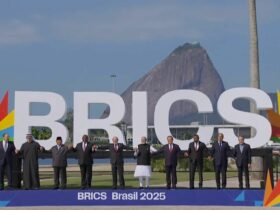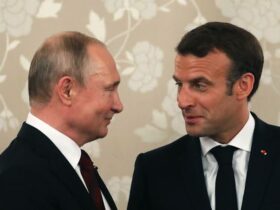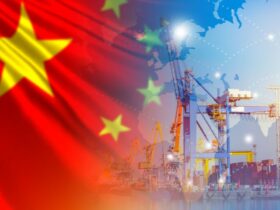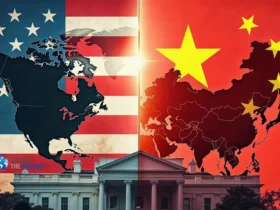By Omar José Hassaan Fariñas*/ Oscar Rotundo**
With the many worries and challenges we face daily, perhaps it is worth celebrating the few good pieces of news we receive from time to time. In this regard, we have just heard that China and the member states of the Community of Latin American and Caribbean States (CELAC) agreed to adopt the China-CELAC Joint Action Plan for Cooperation in Key Areas (2022-2024). The agreement addresses issues of political cooperation, security and, naturally, economic cooperation. Both parties commit to strengthening high-level contacts and meetings between their leaders and representatives, highlighting that a China-CELAC Forum summit will be held in 2024.
Little by little, China is managing to position itself in Latin America and the Caribbean. The last world power to achieve this was the United States, which naturally sets the tone for the Anglo-Saxon power’s opinion on this agreement. It is important for us in Latin America and the Caribbean to understand the implications of this process, since this agreement constitutes a small point on the road towards its consolidation. It is important to appreciate the geopolitical dimensions of this event, why it is happening, and how it fits into the great global geopolitical events and rivalries of our moment in history.
For the purpose of understanding and analysis, it is appropriate to resort to the historical relations between the United States and Latin America, both in the relatively distant past and the present.
The Pan-American initiative – promoted by the United States in 1889 – was a consistent and coherent effort of US foreign policy for over 60 years (until 1948, the year in which the OAS was created), to unite the Latin American republics under a institutional hemispheric architecture dedicated to security and defense issues, and the issue of diplomatic “coherence and consistency” with regard to the rest of the world. Interestingly, although many placed emphasis on the US’ initiatives around economic issues – the opening of markets and control over raw materials – in reality, this Pan Americanist movement was much more interested in security and defense issues.
During the first decades, it attempted to push out potential European competitors: the Russians, the Italians, the Germans, the French, but, above all, the British.
After the creation of the OAS, the goal shifted toward consolidating the anticommunist bloc in the hemisphere (during the first Cold War).
The predatory economic relations between the United States and Latin America did not really require hemispheric institutional frameworks, much less the possibility for our countries to negotiate with the United States as a bloc, particularly in the early days of Pan-Americanism, when British imperialism it still had relevance and influence in certain South American areas (such as Argentina, for example).
The United States had already successfully swallowed all of Central America and transformed it into a bunch of hideous “Banana Republics” – for a time, thankfully – without the need for coercive initiatives and hemispheric institutional dominance.
The opening of markets was achieved through wars, regime change – a favorite practice of the United States, since the actions of William Walker between 1856 to 1860 – or bilateral agreements that in a few years pulverize any endogenous economic autonomy in favor of a total productive and consumerist subordination for the benefit of the United States.
The Latin American and Caribbean republics, after the end of World War II and the notable devastation experienced by all the allied and axis powers with the notable exception of the giant US market and its small appendage in Canada, had no choice but to accept the ‘suffocating embrace’ of America, the same one they had tried to avoid since 1889, surrendering to Washington’s will.
It is not a mere coincidence that the OAS finally came into existence in 1948, rather than before the war. There was simply no alternative for the regional elites. Since then, and throughout the Cold War, while the Latin American republics sought to improve economic relations with the United States (such as access privileges to US markets, technology transfer, non-military technical assistance, etc.) The United States requested more and more military, political, diplomatic and multilateral cooperation.
The issues of security, defense and diplomacy were collective, institutional, hemispheric; the economic issues were bilateral, discreet, or in accordance with the “logic of the market”, of course, this implies the logic of the US market, and no other. It is also not a coincidence that the first “Summit of the Americas”, to address economic issues at the continental or hemispheric level, was held during the presidency of Mr. William Jefferson Clinton, in 1994, well after the end of US geopolitical concerns, and at the height of the unipolarity of the United States.
Latin American conservatism, always loyal to US hegemony in the region, has never been able to hide the bitter taste of economic and institutional relations between the United States and the Latin American and Caribbean region over the decades.
The profound asymmetries became more acute with these “relationships”; the poverty and inequality engendered by them and the destruction of the governments that tried to improve this catastrophic situation, from Jacobo Árbenz through Dilma Roussef and Evo Morales, clearly marked the legacy of the United States in Latin.
The United States knows perfectly well that Latin American and Caribbean people are aware of this reality. The US elites are convinced of the rejection they generate in Latin America, beyond the miserably minority elites of the region, which identify themselves ideologically with the northerners, and with obvious material interests in common, although within the framework of asymmetric and subordinate relations . Nothing more dangerous in the Latin American region than the spread of non-ceremonial and truly diverse electoral processes, particularly from an ideological and socioeconomic perspective, quite unlike those held in the United States, in which the conservative economic candidate usually faces “A”, against the identical economically conservative candidate “B”, to see who will apply exactly the same economic policies. Mixing these sociohistorical realities of US-Latin American relations with genuinely diverse and ideologically differentiated electoral processes is a “recipe for disaster.”
Of course, the disaster is for the United States and the regional elites, and not for the people. Oh that’s the huge difference.
Now, if we take this “explosive” mixture of terrible economic legacies and sociopolitical visibility and political empowerment for the subordinate classes in the socioeconomic hierarchy and we add an immense extra-regional global economic power with “global” status, not for its warmongering conquests but for its immense and unprecedented economic growth and massive infrastructure projects, we will begin to understand why China’s entry into the region is a true nightmare for US geopolitical interests.
As we have pointed out in many other articles, the United States is in a global geopolitical standoff against Russia and China, a confrontation that does not have thematic and/or geographical restrictions.
The confrontation with Russia is the component of the new Cold War with which the United States feels most comfortable, most secure and most confident. This is the case for two reasons: Firstly, the Russia of 2022 is not a global economic power. Even the Soviet Union in its best times was not a real economic “competitor” of the United States, but rather one that offered a different model that would distance potential “Client States” from its orbit of power.
Secondly, where Russia today is indeed a global political power, it is only so strategically and diplomatically, even because of the leadership it supports, which is why Putin must be painted as the new Hitler, Satan and Ayat Allah Al Khomeini in the western media and western political discourse. The United States has a lot of practice in these areas: it understands them, and it can dust off its old tactics to deal with this new threat to its hegemony.
But China is the new nightmare of the 21st century in the context of this new Cold War. As much as they try to label it as imperialists or make accusations of genocide to condemn them (as they do with Erdogan’s Turkey today), no matter how much they try to accuse China of “human rights violations” and having “concentration camps”, as was done in the past (and in the present) with the Russians, the task of “demonizing” China is quite complicated and difficult, with few successes within the Western World itself, and even less in Africa and Latin America, not to mention the Asian continent itself.
Although China is in an accelerated process of military growth, its real and enormous potential lies in its gigantic political-economic-technological capacity.
It is important to see the true scope of Chinese growth and power in the economic and technological fields. We take a single example, to limit the size of the current document.
The gringos, instead of competing freely in an open market against other competitors as they have tried to point out to us (by dint of invasions and massacres) in Latin America since the 19th century, actually think that competition is a good thing only when they are winning.
Seeing that another power can outcompete them, they proceed to try to destroy the competitor through non-economic mechanisms and practices. That was precisely what the Tycoon and symbol par excellence of gringo capitalism, Mr. Donald Trump, intended to do.
The United States, its government and its industries, declared Huawei a mortal enemy of the Anglo-Saxon Republic. They fought it and continue to fight it fiercely, and they still haven’t achieved their goal.
The important thing is that as a result of this attack by a State on a Chinese multinational company (something that would have stoked endless outrage if it were a ‘communist’ government taking action against a Western Multinational) the Beijing government has decided that it will achieve sufficiency and national autonomy in the production of integrated circuits (microchips) by the year 2025.
From a domestic production that feeds only 16% of its needs, the semiconductor industry in China plans to jump to 70% by 2025. This is practically generating an entire industry from its infancy and bringing it to maturity in just five years (the plan was announced in 2020). What is impressive is that many independent observers actually believe that China will achieve its target for the indicated period. This, without mentioning its quantum computing sectors, its 5G networks and its space program.
The United States knows how to compete with Russia. It knows the logic of geopolitical confrontation and the movement of troops and missiles to put pressure, and it knows how to play his favorite game, that of “Brinkmanship” in the nuclear age. What they don’t know how to do is compete economically with someone who grew quantitatively and qualitatively faster than themselves during their global boom, and following the same rules of the system that the gringos imposed, and not others.
In other words, China cannot be accused of being a “revisionist power” as Germany, Italy and Japan were before 1939, since China reached the capacity it has today within the framework of the post-1939 international system.
The United States pretends that it knows how to “stop Putin”, because it is always about stopping an “evil”, and not the country of an “evil”. But it does not know how to stop, let alone reverse, issues such as the signing of the CELAC-China agreement.
The United States dreams of the expulsion of China from the Latin American and Caribbean region, but has not the slightest idea of how to achieve this. The “conservative restoration” that it has promoted in Latin America since the middle of the last decade, although it initially empowered many of its regional clients, is currently not yielding good results.
Proof of this is CELAC itself. China does not need to deceive its partners with the pathetic and misnamed “debt traps” that the gringos are selling to the entire planet as a warning to stay away from the “evil” Chinese. This is the height of hypocrisy, since the true and most gigantic “debt trap” in the history of humanity is made up of the nefarious twins of the “World Bank” and “International Monetary Fund”, the private property of the gringos, and not of the Chinese.
China does not need to create AEOs, nor institutional architectures for the domain. They don’t need invasions and ‘regime’ change to advance their economic project in Latin America and the Caribbean. The Asian power only needs to offer a model in which the benefit is mutual between the parties, and dominance is not a precondition or final requirement, to consolidate this mutual benefit.
China took advantage of the misdeeds of more than a century in forced and violent extraction of wealth, in coups and military invasions carried out by the gringos in Latin America, to offer a different, multipolar, complementary and equitable model, which was received with great enthusiasm by progressive governments that managed to come to power in today’s Latin America, with the legitimacy granted by the massive support of their peoples opposed to the gringo model of looting and exploitation.
For these reasons, the signing of the China-CELAC agreements, and their continuation over time, are acts that Latin American and Caribbean people are celebrating, as they will eventually replace the US’ once hegemonic policies of fire and brimstone.
* Dr. of Strategic Development Sciences in the Bolivarian University of Venezuela, Second Secretary in the Foreign Ministry of the Bolivarian Republic of Venezuela.
** International politics expert and editor at the website PIA Global (International alternative journalism) of Argentina

















Leave a Reply